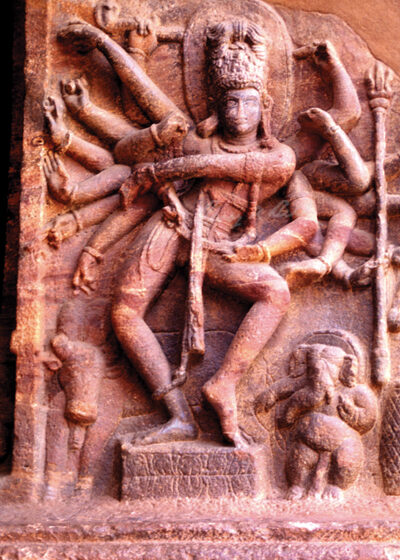Art of the Chalukyas on Badami, Pattadakal, Aihole and Alampur

Shiva sculpture, Cave 1, Badami. Pic by Benoy K Behl
Bonoy K Behl
From the 1st century onwards in India, the human form became the main embodiment of philosophic concepts. These exquisite forms were made to move us and to transport us beyond our worldly concerns, to that which was more important. Temples were conceived as homes for the deity: where the formless eternal takes on a shape to give ‘darshan’ to the devotee. Darshan is the transfer of grace which occurs when we look upon the beauty and harmony of the divine.
Many temples were made in the Gupta period, from the 4th to the 6th centuries CE. However, most were made of brick and have not survived.
The earliest large body of well-preserved temples is of the period of the Early Chalukyas from the 6th to the 8th centuries. These were made near the banks of the Malaprabha River in present-day Karnataka and on the Tungabhadra in Andhra Pradesh.
The Chalukyas rose to power in the mid 6th century and made their capital at Badami.
The red sandstone cliffs of Badami offered a spectacular setting for the excavation of four caves, three Hindu and one Jaina. The largest and most impressive of these is Cave 3, dedicated to Vishnu. An inscription next to a Varaha depiction states that the cave was dedicated in CE 578 by Mangalesa, a brother of King Kirtivarman.
Cave 1 is dedicated to Shiva and is also of the mid 5th century. Projections of the rock face, at right angles to the front of the cave continue the sculptural programme. To the right of the entrance is a magnificent depiction of the Nataraja, Shiva in the cosmic dance. We see here the movement and the multiplicity of the world of creation, yet all held together in the great harmony of the natural order.
The region of the Malaprabha River in the Deccan was a meeting place of the styles of temple building which were developing in north and south India. While temples of other regions have been lost, examples are preserved here because little or no building has taken place in later times.
Aihole is today a small village, in a remote part of Karnataka state. Many of the temples here were used until recently as houses or cattle sheds and are known by the names of their former owners. For instance, the temple of Lad Khan, which was probably built around the end of the 6th century. An inscription states that is was dedicated to Durga.
The Durga temple, most probably of the early 8th century, is apsidal in form. The shape is perennial, though not very common in Indian monuments.
Parts of present-day Andhra Pradesh state had come under the control of the Chalukyas in the 7th century. Here at Alampur are nine temples, called Newa Brahma temples in a later 16th century inscription. These were made at the end of the 7th or the early 8th century. Eight of these are made in the Nagara or northern style.
These are among the finest temples of the Chalukyan period and the most beautiful of them is the Svarga Brahma, constructed in the end of the 7th century in honour of a Queen, by her son.
The temples of Pattadakkal are on the Malaprabha River, a few kilometres from Aihole. These mark the return of Chalukya temple patronage to Karnataka, after several years of activity in the Andhra Pradesh region. The first great temple here is the Galagnatha, which is in the northern style and is similar to the Alampur temples.
It is in the Virupaksha temple that we encounter the full glory of art under the Early Chalukyas. The temple was built in 735 CE by Lokeshwari, a Queen of King Vikramaditya II, to celebrate his victory over the Pallavas of Kanchipuram. It was probably modelled after the Kailashanatha temple at Kanchipuram, which had greatly impressed the king. The Virupaksha would also have served as the model for the Kailashanatha temple built at Ellora by the Rashtrakutas, who succeeded the Chalukyas.
The Virupaksha along with the Kailashanatha at Kanchipuram was probably the largest and most ornate temple in India at that time. The structures are all made of the local red sandstone and elaborately carved.
By the period of the Early Chalukyas in the Deccan, the Indian temple was fully developed. On its outer walls and in the sacred interior were depictions of great beauty and grace. In Indian thought, the moment of the aesthetic experience is considered to be akin to Brahmananda, or the final bliss of salvation itself. When we respond to the grace of creation presented to us in art, we come out of ourselves and experience a greater reality.


